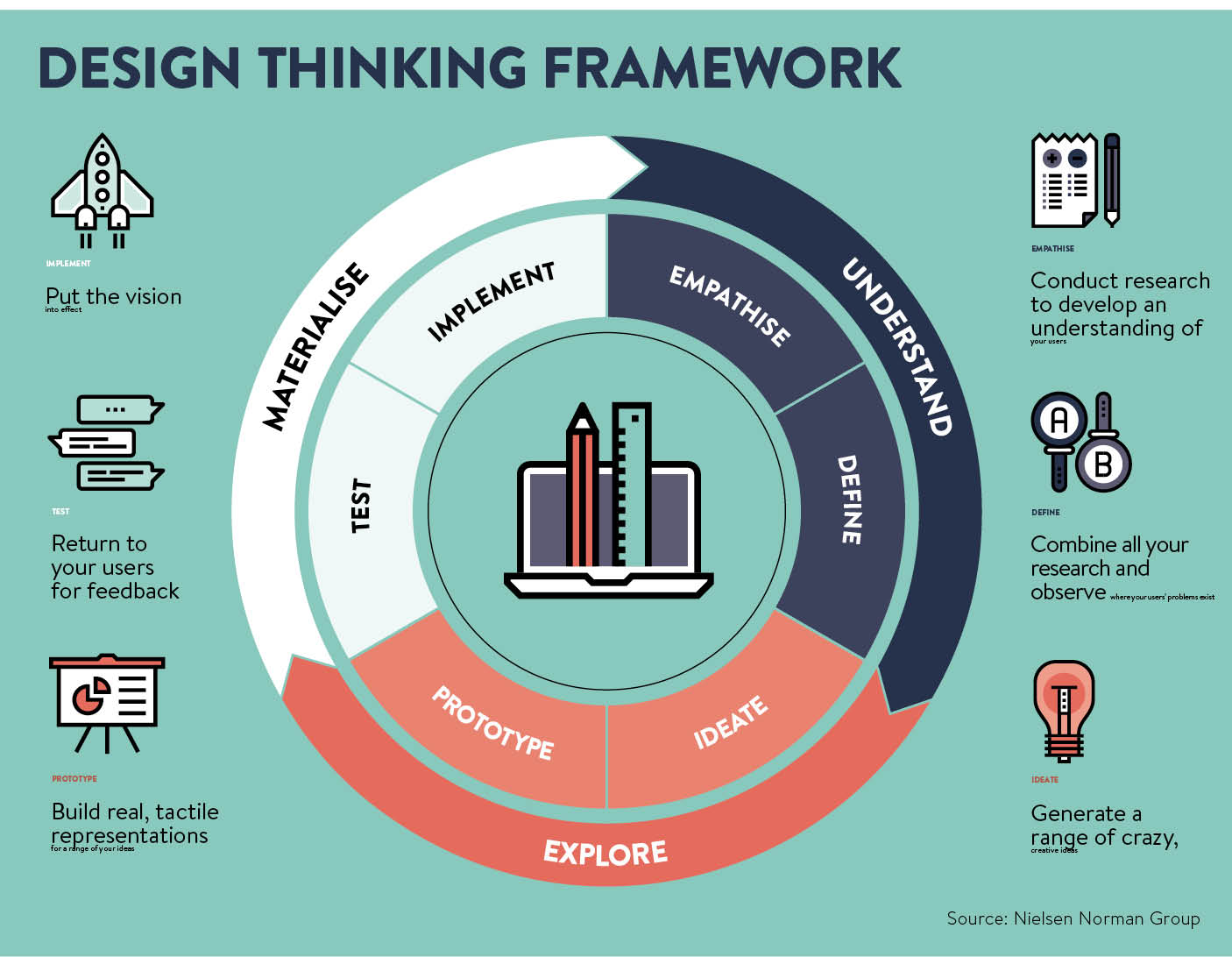When Thomas J. Watson Jr. told IBM staff in the 1970s that “good design is good business”, he started a debate that still rages today.
Design thinking has had failures, but most stem from misunderstanding it as pure creative or pure mechanics. It is both: escalating design principles outside product to empower anyone creating ideas to create for customer needs first, solve complex challenges, drive value and, perhaps above all, create and mobilise a flexible culture fit for addressing today’s digitally transforming world.
How chief executives and the rest of the C-Suite can best put design thinking to work depends on a wider application of it as, to paraphrase IBM’s Maria Morais, a focus on forms, relationships and behaviour. Leaders need, however, to structure and focus it in order to use its principles to drive specific, but still strategic, change.
What is design thinking?

Graphic source: Nielsen Norma Group
Every kind of organisation has its own approach to design thinking, but they share ideas, models, intent and a need for buy-in from top-down leadership and bottom-up cultural change.
Design thinking is inherently innovative, and driving innovation culture to create better products, services, experiences and solve wider challenges is the first and most immediate must-have activity most organisations and leaders associate with it. But a startup mindset, with consumer empathy, fail to succeed, prototyping and user-centric thinking coming together, is even more useful when unpacked and distributed across the business.
Also design thinking is implicitly progressive, focused on shaping everything around it to purpose. This makes it a natural partner for lean programmes, where the emphasis is on the removal of unnecessary action to optimise productivity.
And design thinking is critical in shaping the entire organisation for the future of digital transformation.
It’s critical to ensuring optimum flow of data into analytics processes to inform decisions and empower actions; to continually ensuring people and users are kept at the centre of workflow and interactions; to balanced technology distribution, cloud architecture for example; to cross-functional working that ensures unified brand and business action; to the simplification of products, services and user interfaces; and to the creation of smoother, straight-through processes and the structure of digital ecosystems around an organisation.
Leading brands
Design-led companies, such as Apple, Coca-Cola, IBM, Nike and P&G, outperform the market. For companies such as Airbnb, Path, Netflix, design thinking means analysing problems from a human, aesthetic and holistic point of view, and helps improve product while radically rejuvenating the structure and performance of the organisation.
Most of these organisations are typified by the energy of their customer engagement and digital transformation strategies, product design programme, and startup, design-prototype-test, fail-fast and learn mindsets. But they’re also typified by a different kind of leadership.
Most major organisations still have complex leadership structures filled with complex titles. Today’s naturally design-thinking businesses tend to have flatter, simpler power structures because it’s simpler, keeps the business from being top-heavy, keeps leaders closer to the workflow and creative, innovative process, people and customers that are the core of value, and enables responsiveness.
Implementing change
Flatter power structures are, in every way, more fit for purpose in a rapid, ambiguous, evolving digital context where constant design and redesign is business critical.
Assuming, however, that you as a chief executive cannot simply change the way the leadership structures around you work, you still have to make the decisions that will future-proof and drive the business forward in a more effectively designed, shaped and innovative way. To do this in a way that will drive design-centred thinking depends on three things:
Attracting disruptive, design-minded leaders changes the C-suite to drive relevance. Only 6 per cent of organisations around the world currently have chief digital officers. Fewer have chief data officers. Also lagging behind are leaders for customers, innovation, value, vision, even disruption or experiences. While you have a C-Suite, begin to fill it with non-traditional roles that will drive design thinking to the centre of decision-making.
Also build design-centric traits. It’s incumbent on chief executives looking to make this change happen to learn the lessons of leaders such as Elon Musk, Satya Nadella and Jeff Bezos. They act as catalysts for creativity and communicate big ideas simply; believe in innovation, failure and prototyping; work to solve big challenges and are optimistic about them; are not afraid to break models to create new things; and know they are part of the design – not above it.
Thirdly, create design-obsessed culture. Ultimately, everything comes back to driving behaviours, actions and relationships to create new forms of engagement, experiences and innovation. Driving design culture, promoting and inspiring it with real belief and passion, as well as promoting change across the business means the organisation becomes a single, shaped and aimed unit with belief in itself.
This drive, to bring together the principles of design around the entire organisation to ensure constant forward progress, innovation and competitiveness – the mobilisation and “weaponisation” of culture – is perhaps, in a digital business context, the most vital leadership role a modern chief executive must perform.
WHAT DESIGN MEANS IN DIFFERENT SECTORS
 RETAIL
RETAIL
Emphasis is on experience design, blending physical, digital and cognitive interactions. Customer journey, multichannel strategy and supply chain must be designed into each other seamlessly.
 BANKING
BANKING
Major banks, surrounded by flexible digital players and intermediates like PayPal, are driving design thinking to customer experiences through real-time data and predictive personal products, and inside the business to smooth out processes and innovate.
 MANUFACTURING
MANUFACTURING
Using smart data, bringing product and supply into the same process creates more variants faster. Products are becoming data streams and physical or digital “things”. The internet of things is enabling manufacturers to design more extended relationships with users, for instance in connected cars and thermostats.
 HEALTHCARE
HEALTHCARE
Redesigning care experiences improves patient outcomes and makes care centres more efficient. Driving data across silos of care ensures consistent treatment through clinical experiences that make patients part of care.
What is design thinking?

